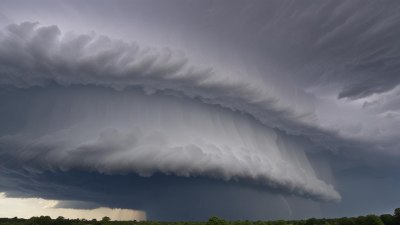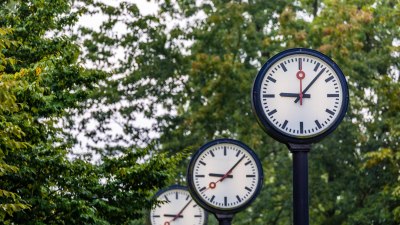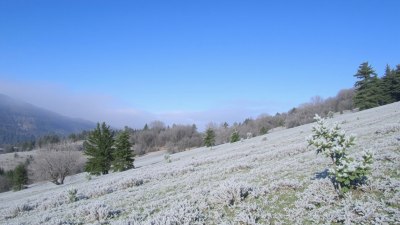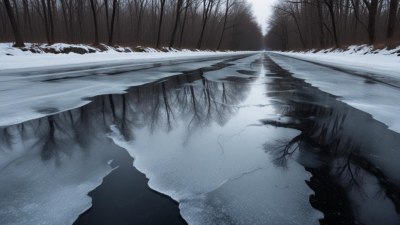How Surface Friction Slows Down Wind Near the Ground
Explore how surface friction reduces wind speed near the ground and its effects on weather and environment.

Image created with Flux Schnell
Wind is a fundamental force of nature that plays a crucial role in shaping our weather and climate. The movement of air masses across the Earth's surface is driven by various factors, including differences in atmospheric pressure, temperature gradients, and the rotation of the Earth. However, one of the most significant influences on wind speed and behavior near the Earth's surface is surface friction. This natural resistance acts as a braking force, slowing down the wind as it moves close to the ground. Understanding how surface friction works and the mechanisms behind it is essential for meteorology, environmental science, and applications such as aviation and urban planning.
What is Surface Friction?
Surface friction, in the context of atmospheric science, refers to the resistance experienced by moving air as it passes over the Earth's surface. Unlike the free atmosphere at higher altitudes, where air moves relatively uninhibited, near the ground, the wind encounters obstacles like vegetation, buildings, hills, and rough terrain. These features disturb the smooth flow of air, creating turbulence and reducing wind speed.
On a molecular level, friction arises from the interaction between the air molecules and the surface elements, causing a transfer of momentum. This transfer slows the wind and changes its direction slightly near the ground compared to higher altitudes. The effect is most pronounced within the atmospheric boundary layer—the lowest part of the atmosphere—where surface features have a direct influence on wind patterns.
The Atmospheric Boundary Layer
The atmospheric boundary layer typically extends from the surface up to 1 to 2 kilometers, fluctuating based on weather conditions and the time of day. It is within this layer that the effects of surface friction are most visible. Above this boundary, wind speeds are generally higher and less affected by topography or obstacles.
Within the boundary layer, the wind profile shows a characteristic increase in speed with height. Close to the ground, friction reduces wind speed significantly, but as you move upward, the wind accelerates due to reduced friction and changes in pressure gradients. This vertical gradient in wind speed is known as wind shear.
Mechanisms of Surface Friction
The primary mechanism of surface friction is mechanical drag. When wind flows over a rough surface, obstacles generate drag forces that convert kinetic energy from the wind into heat and turbulence. This drag absorbs energy from the moving air, leading to a deceleration of the wind near the ground.
Several physical processes contribute to this effect:
- Momentum Exchange: Air molecules in contact with the surface have reduced velocity due to direct interaction with solid objects. Through molecular collisions and turbulent mixing, this slower momentum is transferred upward, gradually reducing wind speed near the surface.
- Turbulence Generation: As wind encounters obstacles, the flow becomes irregular, creating eddies and vortices. These turbulent motions disrupt the laminar flow and lead to energy dissipation.
- Surface Roughness: The complexity and texture of the surface determine the magnitude of friction. Vegetation, urban buildings, and natural terrain features increase roughness and thus enhance frictional effects.
Quantifying Surface Roughness
Scientists quantify surface roughness using a parameter called the roughness length (z0). This value represents the height above the ground where wind speed theoretically drops to zero due to friction. Different surfaces have characteristic roughness lengths:
- Water bodies: z0 ≈ 0.0002 meters (very smooth)
- Grasslands: z0 ≈ 0.01 meters
- Cultivated fields: z0 ≈ 0.03 meters
- Forests: z0 ≈ 1 meter
- Urban areas: z0 ≈ 1 to 2 meters (very rough)
Higher roughness length values correspond to greater friction, which reduces wind speed more significantly. These parameters are crucial for meteorological modeling, helping predict local wind patterns and their impacts.
Effects of Surface Friction on Wind Behavior
Surface friction impacts wind in several ways, influencing not only its speed but also its direction and turbulence:
- Reduction of Wind Speed: The most direct effect is the lowering of wind speed near the surface compared to upper levels. This is why anemometers mounted on towers record higher wind speeds at elevated heights.
- Change in Wind Direction: Friction causes the wind to slow and turn slightly toward lower pressure areas. This deflection is known as the Ekman spiral effect in ocean and atmospheric boundary layers.
- Turbulence Increase: Rough surfaces promote the formation of turbulent eddies, which mix the air and redistribute heat, moisture, and pollutants.
Impact on Weather and Climate
Surface friction is a critical factor in weather phenomena and climate dynamics. For example, it influences the development of local winds such as sea breezes and mountain-valley winds by modulating near-surface wind speeds. It also affects storm behavior; hurricanes and cyclones experience a reduction in wind speed as they approach land due to increased friction, often leading to weakening of the storm.
Furthermore, friction modifies the transport of heat and moisture close to the ground, affecting evaporation rates and the formation of clouds and precipitation. In urban areas, increased surface roughness alters local wind flows, contributing to phenomena like urban heat islands and influencing air quality.
Role in Aviation and Engineering
Understanding surface friction is vital for aviation, particularly during takeoff and landing when aircraft operate close to the ground. Wind speed and turbulence near airports are carefully monitored to ensure safety and optimize flight operations.
In engineering, measurements of wind load on structures consider surface friction effects to design buildings and bridges that withstand local wind conditions. Urban planners also use these concepts to design cities that reduce wind hazards and improve natural ventilation.
Mathematical Representations
Several mathematical models describe the effect of surface friction on wind speed profiles. One common model uses the logarithmic wind profile formula:
u(z) = (u_* / k) * ln(z / z0)
Where u(z) is the wind speed at height z, u_* is the friction velocity, k is the von Kármán constant (approximately 0.4), and z0 is the roughness length.
This formula highlights that wind speed increases logarithmically with height above the surface, with the slope governed by friction velocity and surface roughness. Meteorologists use this relationship to estimate near-ground wind speeds from measurements taken at higher levels.
Surface Friction in Different Environments
The extent of surface friction varies widely depending on the environment:
- Over Oceans: Wind encounters less friction due to the smooth water surface, leading to higher speeds near the surface. However, wave action and sea spray add some complexity to this interaction.
- In Forests: Dense vegetation greatly increases surface roughness, profoundly slowing the wind. This creates a microclimate under the canopy, protecting the forest floor from harsh winds and influencing ecosystem processes.
- Urban Areas: Skyscrapers and buildings produce complex wind patterns, increasing turbulence and friction. These effects can cause wind tunnels or sheltered areas within cities, impacting pedestrians and pollution dispersion.
- Mountains and Hills: Terrain elevation and shape alter wind flow, causing acceleration over ridges and deceleration in valleys because of friction and topographic effects.
Measurement Techniques
Scientists use several methods to measure surface friction effects:
- Anemometers: Devices measure wind speed at various heights to determine vertical gradients.
- LIDAR and SODAR: Remote sensing technologies provide 3D wind profiles and turbulence data.
- Flux Towers: Measure momentum exchange and turbulence between the surface and atmosphere.
- Numerical Models: Simulations incorporate surface roughness parameters to predict wind fields.
Challenges and Research Directions
Despite advances, accurately modeling surface friction remains complex due to the variability of natural surfaces and evolving land use. Climate change and urban expansion alter surface characteristics, necessitating ongoing research to improve predictions.
Researchers are exploring high-resolution computational fluid dynamics models and machine learning techniques to better represent surface friction effects. This effort improves weather forecasting, wind energy assessments, and environmental management.
Implications for Renewable Energy
Wind energy projects depend heavily on understanding how surface friction affects wind speed and turbulence near potential turbine sites. Lower surface roughness typically means higher wind speeds and more efficient power generation. Therefore, selecting appropriate locations requires detailed analysis of local surface friction.
Moreover, friction influences turbine wake effects—turbulent air behind turbines—which can reduce efficiency and cause mechanical wear. Proper spacing and design mitigate these impacts.
Surface friction plays a vital role in slowing down wind near the ground by interacting with the Earth's diverse terrain and built environments. This braking force shapes local wind patterns, influences weather systems, and affects many practical areas such as aviation, urban planning, and renewable energy development. Understanding and accurately modeling surface friction remains a key focus for advancing meteorology and environmental science.











